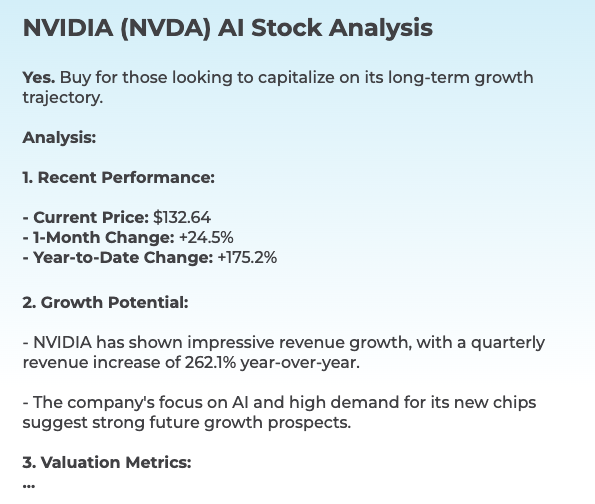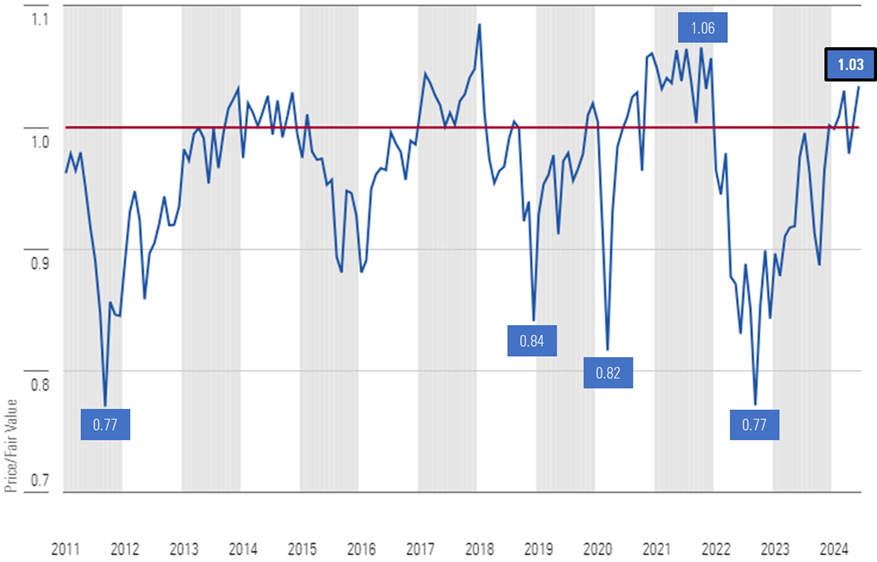20 Great Facts For Selecting AI Stock Trading Platform Websites
20 Great Facts For Selecting AI Stock Trading Platform Websites
Blog Article
Top 10 Tips For Evaluating The Accuracy Of Ai Trading Platforms That Predict Stocks Or Analyze Trading Data
To be certain that the software you select is able to provide reliable information and forecasts, it is essential to assess the accuracy and efficiency of the tool. These are the 10 most important tips to effectively evaluate these platforms:
1. Backtesting Results
What to Look for: See whether the platform provides backtesting in order to see how its predictions have performed based using previous data.
What is the significance of backtesting? Backtesting is a method to test an AI model through comparing the predictions to the results of previous tests.
Search for platforms that permit you to customize backtesting parameters such as time periods and asset classes.
2. Real-time Performance Monitoring
What to look out for: See how the platform performs when it is compared to the the current market conditions.
Why is it important Real-time performance gives a more accurate indicator of its performance instead of relying solely on past backtesting.
Use a free trial or demo account to observe and compare real-time predictions to actual market activity.
3. Prediction Error Metrics
What to Look For: Evaluate metrics like Mean Absolute Error (MAE) and Root Mean Squared Error (RMSE), or R-squared, to measure the accuracy of predictions.
What is important: The metrics measure the reliability of predictions compared to actual results.
Tips: Platforms that have openly shared metrics are generally more transparent.
4. Ratio of Success and Win Rate
What to look out for The platform's success percentage and win rate (percentage of correct predictions).
What is important Why it matters: A high winning rate and success rate indicate higher predictive accuracy and potential profitability.
Keep in mind that no system is flawless.
5. Benchmarking with Market Indices
What to Watch Out For See if you can compare platform predictions and results with major indexes (e.g. S&P 500, NASDAQ).
Why It Matters This will help to determine if a platform is over or underperforming the overall market.
Look for outperformance that remains consistent over time, and not only in the short run.
6. Consistency on Market Conditions
What to Look for: See how the platform performs during various market conditions.
The reason it's important A strong platform works well across every market, not only those that are in good conditions.
Tips: Use the platform in volatile times or market downturns.
7. Transparency in Methodology
What to look for Learn about the AI algorithms and models used (e.g. neural networks or reinforcement learning).
Why it is Important Transparency in methodology lets you determine the validity and scientific rigor of the system.
Avoid platforms that employ "black box models" that don't explain how to generate predictions.
8. Independent testing and User Reviews
What to watch out for: Read user reviews and independent testing and third-party assessments.
Why it's important Reviews, tests and assessments provide objective and objective information about the performance and accuracy of the platform.
TIP: Check for reviews on forums like Reddit, copyright or financial blogs.
9. Risk-Adjusted Returns
What to look out for: Evaluate the platform's performances using risk adjusted metrics like Sharpe Ratios, or Sortino Ratios.
Why It Matters: This metric accounts for the risk involved in order to achieve returns. It offers a more complete view of the performance.
Sharpe ratios (e.g. over 1) indicate a higher risk-adjusted return.
10. Long-term Track Record
What to look for: Find out the overall performance of the platform over time (e.g. 3 to 5 years).
What's the point. Long-term performance may be more reliable than short term results.
TIP: Avoid websites that showcase only quick-term successes or results that are cherry-picked.
Bonus Tip - Try your account by using an online version
Demo accounts or trial versions allow you to check the accuracy of the prediction system in real-time without risking actual money. This allows you to assess the accuracy and effectiveness of the system on your own.
If you follow these guidelines, you can thoroughly evaluate the accuracy and performance of AI analysis and stock prediction platforms, ensuring you choose one that matches your trading goals and the risk you are willing to accept. It is essential to understand that there is no perfect platform. The most effective approach is to combine AI knowledge and your own analysis. See the most popular over at this website for market ai for blog tips including market ai, ai stock picker, ai trading tools, ai investing, ai for stock predictions, options ai, chatgpt copyright, ai stock, ai trade, ai for stock predictions and more.
Top 10 Tips To Assess The Risk Management Aspect Of Ai Stock-Predicting/Analyzing Platforms
Risk management plays an essential function in any AI-based stock trading platform. It safeguards your investment by limiting the risk of losses and helps you to maximize profits. Platforms with robust risk management capabilities can help you navigate volatile stock markets and make decisions based on information. Here are ten top suggestions to help you analyze the risk management capabilities of these platforms.
1. Study Stop-Loss Features and Take Profit features
A level that is customizable: You must be able to modify the take-profit/stop-loss levels of your specific strategies and trades.
Check if you can use trailing stops. These automatically adjust when the market shifts to your advantage.
Stop-loss guarantee: Check to whether the platform offers stop-loss assurances, which assure that your trade will be closed at a specified price in even volatile markets.
2. Assessment Position Sizing Tools
Fixed amount: Make sure that the platform allows you to determine the size of your position based on a fixed monetary amount.
Percentage portfolio: Determine if the risk can be controlled in a proportional way by setting your portfolios as a centage of your overall portfolio.
Risk-reward-ratio: Check if the platform permits users to set individual risk/reward ratios.
3. Make sure you are receiving assistance with diversification.
Multi-asset Trading: To diversify your portfolio of investments, be sure that the platform you choose allows trading across multiple asset classes.
Sector allocation: Determine if the platform offers tools to monitor and control sector exposure.
Diversification of geographic risk: Check if the platform supports trading in international markets to spread the geographic risk.
4. Evaluate Margin and Leverage Controls
Margin requirements: Ensure that the platform is clear about limitations on margins when trading leveraged.
Check to see whether you can establish leverage limits to limit the risk you take.
Margin calls - Examine to see if your service informs you about margin calls in a timely manner. This can help avoid liquidation.
5. Review the Risk Analytics Reporting
Risk metrics. Be sure that the platform has key risk indicators (e.g. VaR, Sharpe Ratio, Drawdown) that are relevant to the portfolio you are managing.
Scenario analysis: Ensure that the platform enables you to simulate different scenarios of the market to assess risks.
Performance reports: Ensure that the platform offers you comprehensive information on the performance of your investments, including returns that are adjusted for risk.
6. Check for Real-Time Risk Monitoring
Monitoring of your portfolio: Make sure the platform allows you to monitor your portfolio in real-time.
Notifications and alerts: Verify whether the platform offers real-time alerts on risk-related events (e.g. Margin breach, Stop-loss triggers).
Make sure you have dashboards that can be customized to provide a comprehensive overview of your risk profile.
7. Test Stress Testing and Backtesting
Stress testing: Check that the platform permits you to test your portfolios or strategies during extremely difficult market conditions.
Backtesting Check to see if your platform supports backtesting using data from the past to assess the risk and performance.
Monte Carlo: Verify the platform's use Monte Carlo-based simulations for assessing the risks and modeling a range of possible outcomes.
8. Assess Compliance with Risk Management Regulations
Check for regulatory compliance: Verify that the platform's compliance with relevant Regulations on Risk Management (e.g. MiFID II for Europe, Reg T for the U.S.).
Best execution: Make sure that the platform follows best execution practices, ensuring trades are executed at the most competitive possible price, minimizing the chance of slippage.
Transparency: Make sure that the platform has clear and transparent disclosures of the risks.
9. Examine for Risks that are User Controlled Parameters
Custom risk rules: Ensure the platform allows you to define custom risk management rules (e.g. the maximum daily loss, or maximum size of the position).
Automated Risk Controls Find out whether the platform has the capability to automate the enforcement of risk management policies in accordance with predetermined parameters.
Manual overrides: Make sure to check whether the platform permits manual overrides for automated risk controls in case of emergencies.
Reviews of User Feedback and Case Studies
User feedback: Review the opinions of users to determine the platform's capacity to manage the risks.
The case studies or testimonials must be used to highlight the platform's capabilities to mitigate risks.
Community forums - Check to see if the platform provides a user-friendly community that is active and where traders are able to share their risk management strategies.
Bonus Tips
Trial period: Take advantage of a demo free or trial period to try the platform’s risk management capabilities in real-world scenarios.
Customer Support: Ensure that the platform is able to provide a comprehensive customer support solution in the event of any risk management-related concerns or questions.
Educational resources: Find out if the platform provides education resources or videos regarding risk management best practices.
By following these tips you can assess the ability of an AI platforms for stock prediction and analysis to control risk. This will help you select a system that protects your capital, and minimizes the possibility of losses. Risk management tools that are durable are crucial for trading on volatile markets. View the most popular stocks ai for more advice including ai stock predictions, investing with ai, best ai penny stocks, best ai trading platform, ai copyright signals, ai stock investing, best ai for stock trading, ai trading tool, stocks ai, ai for trading stocks and more.